#Starline gets worse before he gets better sadly
Explore tagged Tumblr posts
Text
Time for another AU dynamic drop~!
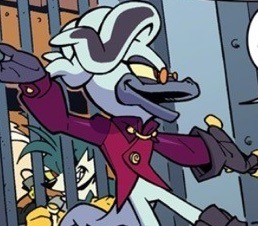
One of my favorite friendships within the competition group is between Starline and Hex.
While Starline really doesn’t take much of a notice of the little rat at first, too focused on trying to get everyone to follow his plan, he does eventually take note when he sees Hex’s work. Kid’s talented, shockingly so for one his age.
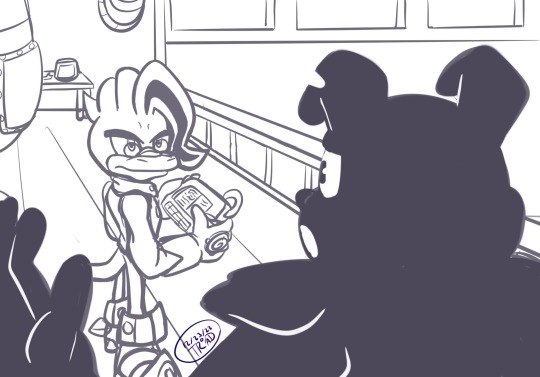
Then he learns from Lug that Hex is debating dropping out of the competition, and goes to talk to him. There, he learns why he joined in the first place, and unintentionally ends up becoming a sort of a big brother/mentor to him for the remainder of the competition.
———————————————————————
📙📗 (Writing Drabble) An Encouraging Word
“People don’t take me seriously because they think I’m too young.” Hex grumpily said as he mashed away at the buttons of his game pad. His eyes narrowed at the flashing ships exploding on the screen. “They always say “I’ll never make it, or I won’t be able to contribute anything worth of value until I’m grown up.”
“I thought by joining this competition I might be able to prove them wrong—that I’m just as capable as they are, but even you guys don’t take me seriously. So then, what’s the point of trying anymore?”
Starline blinked in surprise at the rat’s words, suddenly realizing that this was because the group brushed him off the other day when they all got into thar ugly argument over workflow.
v v v v
He in particular may have said something rather sharp to Hex in his irritation, even if it had been more to keep yet another voice from bombarding him with more info than he could deal with at the time.
Even so, it still had been detrimental to the kid. It was clear that Hex not being given a voice had been hurting the kid for a while now. He was purposefully limiting himself and staying silent because of how he knew the world and his family viewed him and his skills.
…And, Starline supposed he now did the exact same thing. The platypus huffed and frowned. Well, he certainly couldn’t let that stand.
“Hex, I can understand how that conversation may have come across to you.. I certainly said some things I regret in the heat of the moment.. but believe it or not, it’s not that we don’t take up seriously because of your age. Seriously. That’s what everyone’s so hung up about?”
He laughs and leans on the railing. “The absurdity. They simply don’t recognize genius when they see it.”
“Huh?” Hex’s attention is perked.
“Oh certainly. I’ve seen your work, and I can confidently say that I’ve never met a more talented coder and hacker than yourself. If anything, I’d say your age makes what you do even more impressive.”
Hex stops mashing his buttons, squinting in confusion before he stares at the platypus suspiciously. “Wait.. really?”
“Of course!” Starline flashes his trademark, confident smirk.
“You’re.. not just saying that to make me feel better?” Hex presses, not convinced.
“Perish the thought!” Starline exclaims with a dramatic flourish. “I acknowledge I haven’t been… the best at being open to hearing everyone’s ideas.. But your ability with hacking and coding is quite unique, unsurpassed by only a choice few. Anyone who thinks you’re too young to do anything worthwhile and dismisses what you have to offer for that, is either a fool, or just plain jealous of your natural prowess.”
He smiles. “Believe me, Hex. You have a bright future ahead of you.”
“Oh..” Hex flushes in embaressment, looking as if Starline has just opened his mind to a whole new world. The rat gives a small grin as he looks back at his game pad.
“Heh... well… thanks. You’re the first person to say that to me besides Lug. It.. means a lot.”
“Of course! Us geniuses have to stick together after all!”
Hex laughs. There’s a pause, then he pipes up again, seemingly more encouraged. “…Hey, do you think I could show you a personal project of mine sometime? I’d like it if you could check over my work and give me some tips.”
“Oh? Why I’d be delighted.“ Starline replies.
———————————————————————
And from that day on, Starline makes sure to try and let him be part of the planning and conversations going forward. It makes Hex happy.
While the intent of his speech was still very much to encourage Hex to not drop out of the competition, as it’d put them at a huge disadvantage— (Lug would leave with him)— most of WHAT Starline says to him is still shockingly genuine.
Starline sees true promise in Hex, and at times, the kid reminds him of himself. Once small and brilliant, but written off by those with power and authority. “Balderdash to that—” he scoffs with a snort. “Ignore the naysayers and prove them all wrong!” He tells Hex definitively.
(He probably also references a certain young yellow fox in there as extra encouragement, since Tails and Hex are of similar age and he knows Tails has quite a track record himself.)
Hex opens up to him after that conversation. Becomes a chatterbox, going on about complicated coding things and getting Starline’s input on builds since he now knows he’s one of the few older people who will take him seriously and be willing to discuss with him.
This does unfortunately make Lug a bit jealous, seeing as he was Hex’s best friend first and foremost, but he tries hard to not take it personally. “I’m just glad he has someone else to talk to.” He tells Rivet and Charge one day.
#sonic the hedgehog#sonic oc#dr starline#fanart#drabble#lug and starlines dynamic is a whole nother story whew#hes either surrounded by people who don’t like him or people that love him#but yeah it’s cute how Hex looks up to Starline#until later of course and then it’s just sad#Starline gets worse before he gets better sadly#believe me or not Hexs name came to me before i reached Starline reading about Lost Hex#yet another unfortunate similarity that i can’t bring myself to change sggsfsndfh#especially since Hex literally has a hex bolt stuck around his neck#unnamed au#sonic au#sonic#sonic idw#starpoint au#starline the platypus#hex the rat#lug the dog#character dynamics#writing#short fanfic#story post#i lied about it all being text inspiration struck suddenly again
6 notes
·
View notes
Text
The Way of Masters
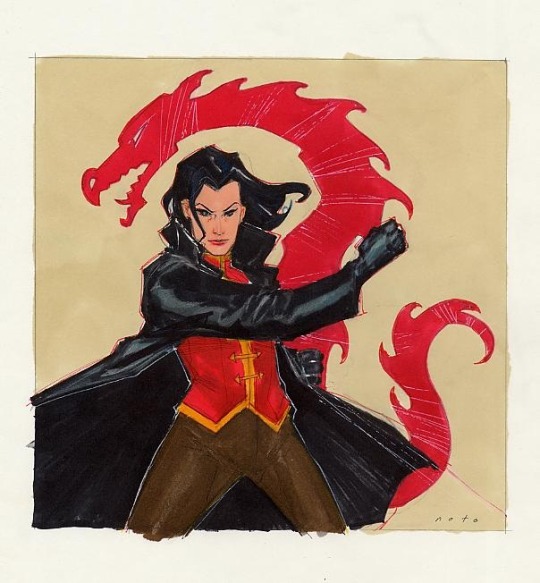
(art by Phil Noto)
So with her likely upcoming appearances in Young Justice and maybe Gotham and maybe Birds of Prey, I’ve had Lady Shiva on my mind again. Well... more than usual. And I managed to keep it bottled up so far but now I feel those urges again so let’s at least try to channel them into some hopefully decent comic book analysis. Today’s subject: why I can never get really behind any story that involves Lady Shiva teaching anyone martial arts.
Expect the usual copious amounts of NOT MUH under the jump:
The concept of Lady Shiva as a teacher comes from two main sources: Jim Starlin’s Death in the Family, which established her as a teacher for hire, and Chuck Dixon’s first Robin miniseries, where Tim Drake ran into her and asked her to train him. It was further solidified in Gulacy and Dixon’s Knightsend, where she helped Bruce get his kung fu mojo back after healing from his spine injury. And then there was Gail Simone’s Birds of Prey, where Shiva trained Dinah Lance to try and turn her into her successor. On top of all that, there’s New52 Shiva having trained Jason Todd, and while I have no idea if it’s been confirmed in canon, I’m like 90% sure she must’ve trained Damian at some point too. So it’s pretty much a solidly established fact that Shiva trains people.
And I personally find it to be a fundamental misunderstanding of her character.
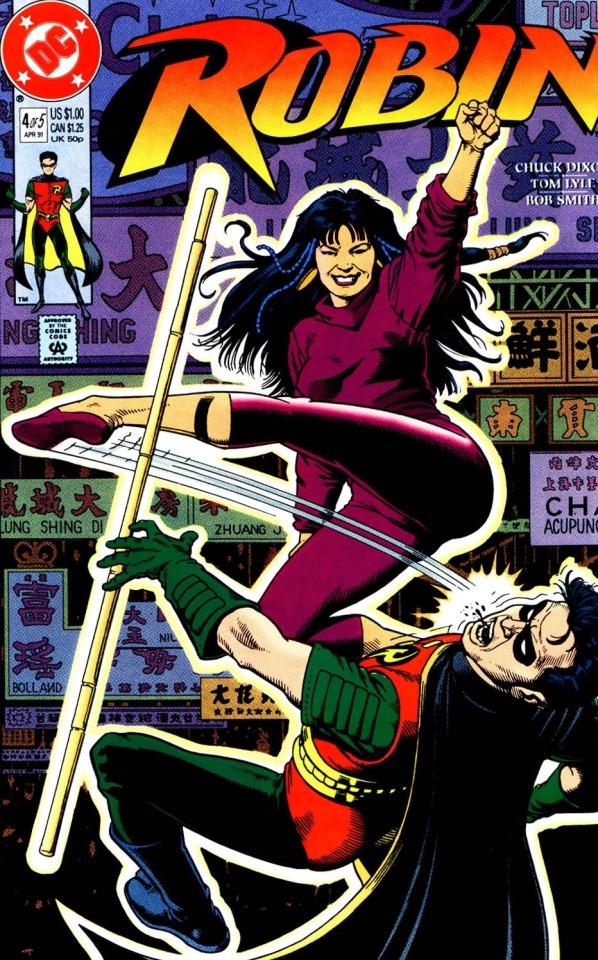
(art by Brian Bolland)
Now, first of all, logistics-wise I have a problem with people repeatedly going to train with a known killer when guys like Richard Dragon are just, y’know, there. And while there’s a dozen of possible in-universe explanations that you could possibly wield (It’s faster! It’s harder! It allows you to learn her techniques should you ever have to fight her!), ultimately I think the best explanation is just that it’s more dramatic. To be trained by someone diametrically opposed to your ideology in stuff you want to know but have vowed not to use is an absolute no-brainer in terms of dramatic tension. And that’s exactly why I don’t like it from the start: because every. Single. Story. That involves Shiva training anyone always ends in the exact same place: with Shiva ordering her student to kill and her student refusing to. Or in Bruce’s case, just pretending he killed someone.
This is nothing but a pointless exercise in character reaffirmation that does nobody any favors. Of course Batman/Robin/Black Canary is not going to kill anybody. Tempting them with it is just going through the motions. It was old hat in the 90s, let alone now. And yet, in one form or another, it just keeps happening. And it keeps happening because none of these stories are really concerned with Shiva herself. They are stories about Batman/Robin/Black Canary getting stronger, with Shiva used as a tool whose characterization is based on the most surface-level reading possible of her. The problem is that these stories also feed into each other, just like how Hush establishing Shiva as a member of the League of Shadows snowballed into this hellscape where she’s literally nothing but a member of the League of Shadows. Lack of interest in her actual character creates and perpetuates these misunderstandings until nothing else exists. But now the question becomes, well, what is her actual character? Good question.
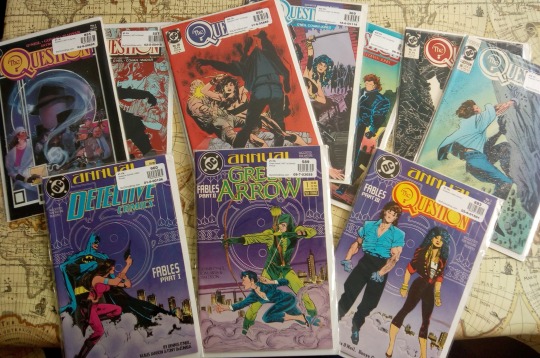
So in Denny O’Neil’s Question run, which I am never going to shut up about until everyone who even thinks about writing Lady Shiva reads through at least twice, Shiva physically and metaphorically kills Vic Sage, then saves his life. I’ve talked about this before but the short of it is that not only does she kill his body, but by presenting him with something he can’t understand, she also kills his stoic, narrow-minded idea of a black and white world. But once she’s saved him, she doesn’t stick around to train him. Instead, she gives him the address of the aforementioned Richard Dragon, who takes him in as a pupil. And this is where things start getting a bit floaty.
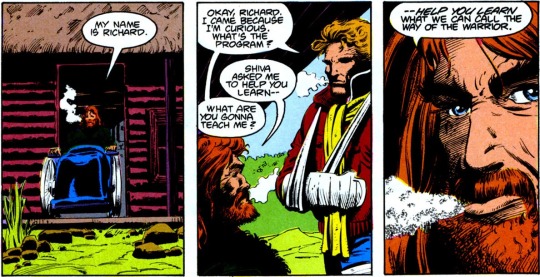
(art by Denys Cowan)
Because there’s a difference between teaching someone and helping them learn it on their own. Zen Buddhists know this. The idea is not to build a path for someone, or to guide them through it. The path is unique to every person and they have to walk it by themselves. But that doesn’t mean you can’t at least point them towards it. Which is what Richard does. Sure, he teaches Vic how to fight, but way later in the run, Richard explains how unimportant that is:
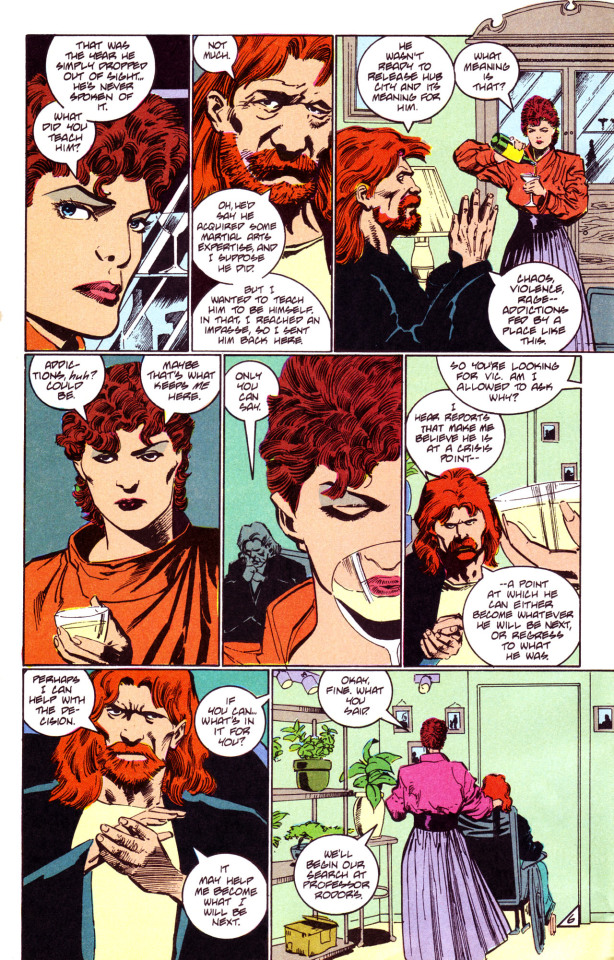
And make no mistake: Shiva is very similar to Richard in this aspect. Her interest in Vic is not about whether he can become a mighty warrior, but in what motivates him. She’s interested in seeing how Vic develops, and her reasons are, in her own veiled way, pretty much the same as Richard’s:
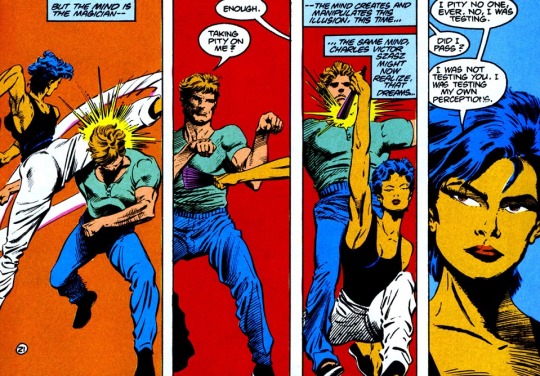
Right before this page, Richard explained that Shiva thinks Vic is fueled by a lust for combat, while he argues that it’s curiosity that motivates him. And the book never gives a clear-cut answer, showing Vic as an intensely curious creature (in fact, it was his curiosity about Shiva’s motivation that helped tear down his old black-and-white worldview) but also as someone prone to seeking the simplicity of punching dudes in the fucking face when the world gets too complex. Which is part of the genius of this Question run: nobody is ever that simple.
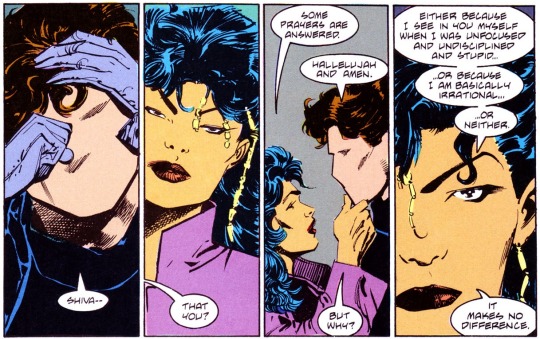
Now, it’s possible to transfer this to the exampled provided below and say that Shiva is similarly interested in Robin/Batman/Black Canary’s development. But only if you don’t really go any deeper than the pure surface. Because the difference here is that at no point through the entire Question run does Shiva demand that Vic take a life. She doesn’t want to prove to him that her way is superior, or that killing people makes you better. She doesn’t want Vic to become like her. She’s just interested in seeing how, once violently stripped of all his preconceived notions and brought back as an almost clean slate, he evolves. And it’s an evolution Shiva has respect for.

And that’s why I can’t get behind any story about Shiva as a teacher. Because just like Richard, she’s not there to try and tempt people to walk her same path of slaughter, sneering smugly at their heroic ideals of the sacredness of life. That’s a dangerously bi-dimensional reading of her that leads to endless rehashes of tired plotlines that go to the same wretchedly familiar places we’ve been to a thousand times before. There’s no deeper insight into the character of Tim Drake or Bruce Wayne to be gained by putting them in a situation where they’re forced to kill but they don’t. There’s no evolution, no characterization, there’s nothing to be gained except for a physical upgrade. And while they may not lose much from just going through the motions over and over again, Shiva gets it so much worse because her character is eroded by these nothing plots.
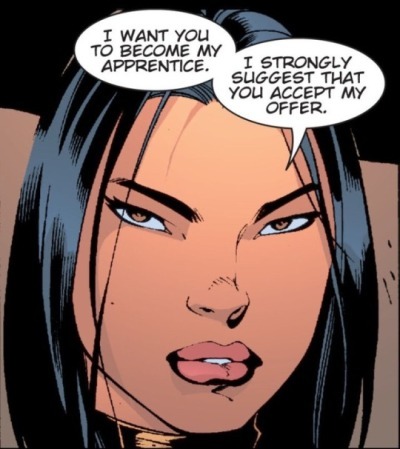
(art by Ed Benes)
In BoP, Simone tried to give Shiva a new reason to actively seek an apprentice, which at least demonstrates more agency on her part than the usual row of Bat-people knocking at her door. Simone’s Shiva is preoccupied with the future and creating a legacy, but again, that’s an idea I just can’t get behind at all. To have a character as steeped into Zen Buddhism and Taoism as Lady Shiva worry about life after death feels like a betrayal, and wanting to turn Dinah into a new version of herself clashes with everything explained above. And Starlin, Dixon, Gulacy, Loeb, Gabrych and Tynion IV don’t even try. It’s enough to make one wonder, is there any writer who actually paid attention when reading Question?
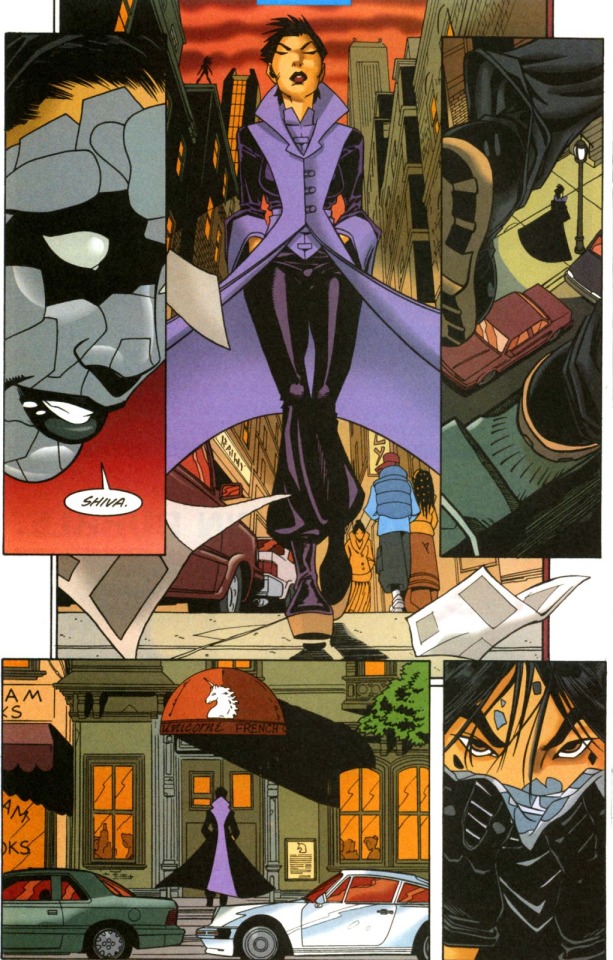
(art by Damion Scott)
Look, call this a reach, but I think there’s a pretty good reason why Lady Shiva’s first appearance in Kelley Puckett’s Batgirl has her wearing a purple coat that’s basically an update of her design in the very first issue of Question. And considering Puckett actually collaborated with O’Neil on the tail end of that run, it’s not even that far of a reach. More importantly, however, Shiva treats Cassandra pretty much the exact same way as she treats Vic: she tears her apart and then leaves her alone for a year so she can rebuild herself. That’s not to say it’s a 100% perfect callback. She does help Cass get her body-reading skills back, and sadly, some of Shiva’s kill-crazy personality has seeped in, making her give speeches about how Cassandra is a waste because she doesn’t kill and how if they are to fight they must fight to the death and whatnot. Which makes sense for Cassandra’s development since rejecting such notions is a big part of her character, although that doesn’t make it any less tired.
But ultimately, the reason why I bring up Puckett’s Shiva is because he’s pretty much the only one to actually take those aspects of O’Neil’s Shiva and bring them back into the light. In a perfect world, the whole “you must kill” thing wouldn’t exist and Shiva would just be satisfied with seeing Cassandra develop on her own. And as we move further into pure headcanon territory, I think O’Neil’s Shiva would be downright fascinated by the idea of someone becoming stronger than her in their own terms rather than just by trying to be like her in every way. Sadly, Puckett’s Shiva doesn’t stick the landing, since the respect she shows for Vic’s personal growth is nowhere to be seen here. And once Gabrych takes over, we’re right back into caricature mode, where we’ve stayed for over a decade save for that one Blackest Night Question special. Which was co-written by, big surprise here, Denny O’Neil.
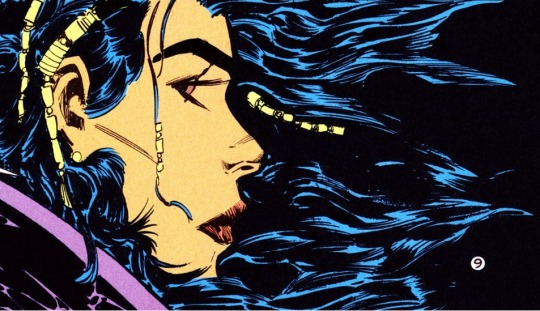
I understand why writers go for it. It’s simple, it’s dramatic, it’s familiar, and it gives their characters something to brag about. “Trained by the greatest martial artists in the DCU, including Lady Shiva” is used to describe even people like Cassandra who never actually trained under her. But I think it’s an error. And I find the alternative not just more gripping and compelling but also ripe with possibilities for both characters in the equation. It forces the person writing it to sit down and think what could Shiva find interesting in each character, and how they could be changed by her presence, framing it all as a two-sided journey of self discovery rather than a melodramatic ideological struggle of which we all know the ending. All you have to do is stop treating one of the most interesting characters in modern DC as a tool to make others get better at punching.
#Lady Shiva#DC#Batman#Robin#Batgirl#Denny O'Neil#Kelley Puckett#Comic books#Ramblings#First Shiva Rant of 2019#Look#I made it to two whole days#That's gotta count for something#Right?
68 notes
·
View notes
Text
Episode Reviews - Star Trek The Next Generation Season 1 (4 of 6)
Ok, loyal readers, one last round of reviews for season 1 of Star Trek TNG while we’re still in January, and then the rest can be left to next month. Without further ado, here’s my look at episodes 15 to 19 of that season…
Episode 15: 11001001
Plot (as adapted from Wikipedia):
The Federation starship Enterprise arrives at Starbase 74 for a routine maintenance check. Captain Jean-Luc Picard and Commander William Riker greet Starbase Commander Quinteros and two pairs of small humanoid aliens known as Bynars; the Bynars heavily rely on their computer technology and work in pairs for best efficiency. Much of the crew take shore leave while Picard, Riker and a skeleton crew remain aboard. Riker is intrigued by the Bynars' claimed upgrades to the holodeck and starts a program in a jazz bar. The program includes a woman named Minuet, by whom Riker is fascinated, both as a beautiful and charming woman, but also by the level of sophistication in her responses. Riker is soon enthralled by the program, and Picard later walks in on him kissing Minuet, and he too is amazed by the simulation.
Meanwhile, a catastrophic containment failure is detected in the ship's warp core. Lt. Cmdr. Data and Lt. Geordi La Forge are unable to locate Picard or Riker and, assuming them to already be on the Starbase, order an emergency evacuation. They set the ship to leave the Starbase and warp to a safe location before it would explode. However, once they are clear of the dock, the failure disappears and the ship sets course for the Bynar system, the planet Bynaus orbiting Beta Magellan. Data, La Forge, and Quinteros realize that the Bynars are still aboard the ship, but there are currently no other working vessels to follow them. Back on the Enterprise, Riker and Picard leave the simulation to find the ship empty and at warp to the Bynar system, with the ship's controls locked to the bridge. Fearing that the Bynars have taken over the ship for nefarious purposes, they set the ship to self-destruct in 5 minutes and then take the bridge by intra-ship transporter beam and find the Bynars there unconscious.
After cancelling the self-destruct, they find the Bynars have uploaded massive amounts of information to the Enterprise computers, but they are unable to decode it. Realizing that Minuet was purposely created by the Bynars to distract them, Picard and Riker ask the simulation about what is going on as the ship nears the orbit of Bynaus. Minuet explains that a star near the Bynar homeworld had gone supernova, and the EMP it emitted would knock out their computer systems, effectively killing the Bynars. They had used the Enterprise to upload their computer information for safekeeping and then planned to download it back to the Bynar computers after the threat of the EMP had passed. With Data's help, Picard and Riker successfully download the data, and the Bynars recover. They apologize for their actions, having feared that Starfleet would refuse to help, though Picard notes they only had to ask. As the Enterprise returns to Starbase 74, Riker returns to the holodeck to thank Minuet but finds that without the Bynar data, the simulation has regressed to the expected norm for the holodeck, and while Minuet still exists, she is not the same as before. Riker reports to Picard that Minuet is gone.
Review:
This episode could be one of the best of the first season of TNG, if it knew what to be. First, we get the Bynars, who are an interesting concept along the lines of human-machine interface and the general concept of cyborg races, but that isn’t explored to any great degree. Next, we get another advancement in holodeck characters in the form of Minuet, who displays an incredible degree of awareness and interactivity that would pave the way for audiences to buy into characters in later Trek like TNG’s sentient Moriarty programme, DS9’s Vic Fontaine and the Fair Haven townspeople on Voyager.
However, the Bynar plot elements prevent us from exploring fully just how realistic Minuet was. In essence, the two plots interrupt each other for a random starship heist that comes out of the proverbial blue. It is interesting, however, to see Data reproaching himself for being busy with exploring the idea of creativity in his quarters when the ship gets into trouble. It’s a remarkably human trait for Data to have at this stage in his character arc, and is a testament to Spiner’s ability to play the character so well that it doesn’t feel out of place.
That said, Riker’s comment about ‘a blind man teaching an android how to paint’ being ‘worth a page or two in somebody’s book’ feels a little dismissive towards those who are differently abled. Given that Geordi can see in his own way, his visor being just a sci-fi metaphor for how the blind simply rely more on their other senses in real life, I see nothing remarkable about him being the one to teach Data about art. Art is not about your senses or even your hands; it comes from the heart and mind, from who a person is, and their desire to express a feeling or idea. People who are blind are no more or less capable of producing art than those who are sighted; they just have to pick a medium that works for them, same as any artist does. Overall, I give this episode about 6 out of 10.
Episode 16: Too Short A Season
Plot (as adapted from Wikipedia):
The Enterprise, under the command of Captain Jean-Luc Picard, brings aboard the elderly Admiral Mark Jameson and his wife Anne on request of Karnas, the Governor of Mordan IV. Karnas warns that a dissident terrorist group has taken a Federation Ambassador and his staff hostage, and demand to speak to a Federation negotiator. Jameson had negotiated a previous settlement on Mordan IV. As the ship travels to Mordan IV, Jameson becomes stronger and more able to move about on his own, and no longer shows signs of the incurable Iverson's Disease he was known to have before he was beamed aboard. Jameson admits to taking an array of drugs to reverse the aging process over the last two years, and only recently has taken an overdose of the drugs to prepare himself for the negotiations. Jameson begins to appear younger and full of energy, but has frequent pains as a result of the overdose. By the time they are nearing Mordan, Jameson appears as a young adult.
As they approach the planet, Jameson begins communication with Karnas to learn more of the situation, but soon intuits that it is Karnas himself that has taken the Federation staff. Karnas reminds Jameson that his treachery during their last encounter on Mordan IV resulted in years of war. Against the advice of Picard, Jameson devises plans to rescue the hostages by transporting the away team to the tunnels beneath Karnas' mansion, where Jameson believes the hostages are being held. Picard privately confronts Jameson about Karnas' motives. Jameson reveals that in the past, Karnas captured a Federation starliner in revenge for the death of his father by another local tribe. Jameson negotiated for the passengers' release by giving Karnas what he demanded, a supply of Federation weapons. However, Jameson, in his interpretation of the Prime Directive, also supplied the warring tribes with the same weapons to keep all sides in the conflict on even terms. Jameson had thought this would only lead to a short-lived skirmish, and had not expected a war that would last over forty years. Jameson is now insistent on correcting his past mistake and thus took the reverse aging drug in order to be at his best.
In orbit, the Enterprise crew and Jameson beam down into the tunnels beneath Karnas' manor, but find that their arrival was anticipated and face off against armed guards. Jameson collapses during the fight, and the crew beams back to the Enterprise. Jameson was not shot, but the reverse aging drug is destroying his body. Karnas demands to see Jameson or he will kill a hostage every 15 minutes. Picard opts to beam himself, Dr Crusher, Jameson, and eventually Jameson's wife Anne directly to Karnas' office. Karnas refuses to believe that the young man is Jameson, so Jameson reveals a scar on his wrist inflicted by Karnas years ago. Jameson dies shortly afterward in his wife's embrace. Karnas agrees to let the hostages go, and to allow Jameson to be buried on Mordan IV at Anne's request.
Review:
This is another example of TNG getting a decent premise for an episode and then bottling the execution, which as we’ve seen from all my reviews up to this point was par for the course on the first season. The idea of a proverbial “fountain of youth” isn’t really explored in any depth or detail, making any argument the episode might be making against fighting the process of aging inaudible. The episode would have been better served by chucking that story out and putting more time into the guest character of Admiral Jameson turning out to be a dirty Star Fleet officer. The idea that a Star Fleet officer might really cross the line with the Prime Directive seems far more interesting, as it would have added a little more realism to Roddenbery’s ideal of the future that Trek is supposed to be.
Sadly, like many reviewers, I find that the episode is too focused on Jameson over both story ideas that the main cast are virtually demoted to extras, and this is made even worse by the guest actor somewhat over-playing the scenes where he’s an old man. Overall, the episode ends up as just filler on the way to better episodes later on the series as a whole. I’d give this one about 3 out of 10.
Episode 17: When The Bough Breaks
Plot (as adapted from Wikipedia):
The Enterprise enters the Epsilon Mynos system, searching for the legendary world of Aldea. The planet de-cloaks, and reveals itself to the ship. The Aldeans beam down Commander William Riker, Counsellor Deanna Troi, and Chief Medical Officer Beverly Crusher to the planet. The Aldeans explain that they have been unable to bear children for many years and revealed themselves to the Enterprise in hopes they could trade their advanced technology for some of the Enterprise's children so that they can re-populate their world. Riker refuses and the crew are returned to the Enterprise. Simultaneously, seven children, including young Wesley Crusher, are taken down to the planet protected by a planetary energy shield that the crew of the Enterprise are unable to penetrate. While the Aldean elders attempt to integrate the children into their society, Wesley is shown the "Custodian", an ancient computer system that the Aldeans rely on but do not understand.
As Captain Jean-Luc Picard attempts to negotiate with the Aldeans, they briefly allow Dr Crusher to reunite with her son on the planet. Wesley hints about the Custodian to her, while she secretly passes him a tricorder to scan the Aldeans. After Picard fails to get the Aldeans to agree to the children's return, they fire an energy weapon that sends the Enterprise three days away from Aldea at maximum warp. The Aldeans warn that they can send the Enterprise an impossibly far distance if they refuse to cooperate. During the return trip, Dr Crusher reviews the scanner results and finds the Aldeans are suffering from radiation poisoning, which has harmed their reproductive capabilities but can be reversed if the source is discovered. On arrival back at the planet, Picard orders the crew to try to find a way through the planet's shield while he restarts negotiations.
Wesley, aware the Enterprise is in orbit, arranges for the children to passively resist. When the Aldeans request Picard's help to resolve the issue with the children, the crew finds a way to beam through the shield, allowing Commander Riker and Lt. Commander Data to sneak onto the planet. Data manages to disable the Custodian, disrupting the Aldean's transporter and planetary shield. Dr Crusher explains to the Aldeans that their shield has weakened the ozone layer of their planet, exposing the inhabitants to ultraviolet radiation that has left them unable to bear children. The radiation would likely have the same effects on the children from the Enterprise. Without the planetary shield, the ozone layer will naturally return, allowing the Aldeans to reproduce again. The Aldeans recognize the error of their ways and return the children to the Enterprise. They accept Starfleet's help to correct their ancient systems and recognize that they will have to forgo their invisibility to continue their society.
Review:
While some reviewers have apparently disliked this episode for its point about how humans at the time of the show, and still today, mess up the ozone layer being unsubtle, I disagree. Unlike the people of the Star Trek universe, real world humanity can’t just pick up and warp off to another life-sustaining world if we muck our own planet up beyond even the possibility of repair. As such, any form of fiction that’s trying to press this point should never be subtle. It has to press it home, hard, and if needs be it needs to hammer an audience about the head with the point until it sticks, and let’s face it, the idea that ozone depletion could cause mass infertility and drive a society into becoming child snatchers is an interesting take on the idea.
The problem this episode suffers, however, is that the Aldeans so effectively keep the Enterprise crew on the back foot that they aren’t able to provide the level of visceral response a plot like this needs. Picard’s initial verbal outrage is about as good as we get in terms of any primal response from the Federation adults, and the children don’t display the level of resistance they should considering they’ve been effectively kidnapped. Franchises like CSI or NCIS do better in this line, especially with regards to rescuing the children and punishing their abductors.
I don’t care what the excuse is for the Aldean’s behaviour; Picard should have had Riker and Data take down the shield around Aldea, beamed all his people back to the Enterprise and fired a spread of photon torpedoes down from orbit as a punitive measure. The idea that there’s no real reprisal for the Aldeans for being a bunch of heartless child abductors is what makes me really dislike this episode. If letting such barbarism and criminality go unpunished is what the utopian future of Trek demands, then I think we need to stop just short of that future and never, ever realise it completely.
All that said, we get one of the better performances so far from Wil Wheaton as Wesley, and Picard is decidedly improved in terms of how he behaves around children. However, the lack of a phaser-heavy resolution to the child abduction aspect of the story means I can’t see this as a good episode at all. The few plus points of the episode only get it up to a score of 3 out of 10.
Episode 18: Home Soil
Plot (as adapted from Wikipedia):
Diverted from exploring the Pleiades, the Enterprise arrives at the terraforming colony on Velara III, as the project is behind schedule. The director, Kurt Mandl, insists they are on time but Captain Jean-Luc Picard orders an away team to the surface after Counsellor Deanna Troi senses that Mandl is hiding something. After they arrive, one of Mandl's team is killed by a malfunctioning laser drill. During Lt. Commander Data's inspection of the tool, it begins to fire at him, but his quick android reflexes allow him to dodge the shot and render the drill harmless. He finds the programming of the laser was rewritten to fire upon the staff. Nearby, a crystal is discovered giving off irregular light and radiation patterns. The crystal is brought aboard the Enterprise to study and Picard orders a halt to the terraforming.
Dr Beverly Crusher and Data discover the crystal may be alive. When the crystal attempts to interact with the Enterprise's computers, it is placed into a containment force field. The crystal begins to grow and gains access to the computer's translation program and attempts to communicate with the crew, treating the humans as an enemy, derisively calling them "ugly bags of mostly water". Picard discovers that Mandl and his team previously encountered the crystals; at the time, they knew about light patterns coming from them, but never considered the possibility that the crystals were alive. The terraformers used a drilling process responsible for removing the saline water layer from the water table of Velara III. This saline layer acted as a conductor, allowing many separate crystals to function as one life form. In a defensive response to the drilling, the crystal life form rewrote the laser's software and attacked the terraformers.
Data hypothesizes that a single crystal is not intelligent, but when linked to other crystals, their intelligence is formidable. As the crystalline life form accesses higher-level functions of the Enterprise's computer, Picard and the crew try to transport it to the surface but the crystal blocks all attempts to transport it off the ship. Data and Lt. Geordi La Forge discover the presence of cadmium in the crystal and suspect it has photoelectric properties. They disable the lights in the medical lab and the crystal immediately begs for life. Picard peacefully negotiates to return the crystal life form to the surface of the planet where Starfleet will institute a quarantine, leaving the life form to live in peace.
Review:
This episode is a quite bland and largely forgettable enterprise (pardon the pun) by those who made this series. Other reviewers have apparently noted a similarity to the original series of Star Trek, but as someone whose fandom of Trek is primarily related to the Picard-Sisko-Janeway era and only enjoys Kirk’s crew in their rebooted film format, I’m not about to go looking into that. Instead, I look at the episode itself, which falls flat about halfway through.
The area where the episode falls apart is right around the time we start going into the idea of an inorganic crystalline structure being alive. Up until that point, the way the terraformers acted, one of them dying and Data then almost going the same way all seemed to point to one thing; a possible murder-mystery, and with Data’s fascination with Sherlock Holmes and Picard’s affinity for Dixon Hill, we could have had a great mystery story. Instead, we go full-tilt into a very sci-fi plot that doesn’t reveal much of a point plot-wise. Granted, the metaphor of inorganic life being accidentally destroyed by haste and the desire to play god with one’s environment is good Trek fare, or at least in keeping with general Trek tradition. However, we already saw a crystal-based lifeform back in Datalore, and we just had an eco-friendly message in the episode right before this one. As such, the episode lacks continuity and variation enough to make it anything really good. I’d give it only 4 out of 10.
Episode 19: Coming Of Age
Plot (as adapted from Wikipedia):
Captain Jean-Luc Picard greets his friend Admiral Gregory Quinn and his assistant Lt. Commander Dexter Remmick aboard the Enterprise. For classified reasons, Quinn has ordered Remmick to perform an investigation of the Enterprise and its crew and expects Picard to fully co-operate. Remmick's inquiry causes tension in the crew, particularly when he questions the trustworthiness of the senior staff based on their personal logs and past actions. A young cadet, having failed the Starfleet Academy entrance examination, attempts to run away in a shuttlecraft but ends up drifting. Picard is able to direct the cadet to pilot the shuttle away from a planet by bouncing off the atmosphere.
The investigation is completed, and Remmick informs both Picard and Quinn that there is no sign of wrongdoing, and expresses his interest in joining its crew in the future. Quinn tells Picard that he feels there is an unknown force that may have infiltrated Starfleet, and he was seeking to assure himself of his trust in Picard and the Enterprise crew. To help combat this threat, Quinn offers Picard a promotion to Commandant of Starfleet Academy which would place Picard near Quinn at all times. Picard mulls the offer for some time, but eventually declines.
Meanwhile, Wesley Crusher prepares to take the Academy entrance exam himself. He succeeds in passing several parts of the exam, and helps Mordock, a highly talented Benzite and fellow competitor, to solve a difficult test problem so that they may both advance. Wesley is worried about the psychological part of the exam, and he is directed to a room to wait for the test to start.
While waiting, he hears an explosion nearby, and leaves the room to investigate. He finds two men trapped by fallen components in a fire-engulfed room. Wesley helps to release one man wounded under a heavy pipe, and tries to coax the other man to leave the burning room, but the man is frozen with fear. Wesley is forced to abandon him and drags the other man to safety. Outside the room, he discovers the explosion was fake and this was the psychological test: to see whether he could make a difficult decision (rescuing either man would pass the test).
Eventually, the cadets are told of the results, and Mordock is granted admission into Starfleet Academy, while Wesley is encouraged to try again next year. Mordock thanks Wesley for his help and wishes him future success. After Wesley returns to the Enterprise, Picard confides in him that he also failed the examination the first time.
Review:
Coming Of Age is the first episode of this show that hasn’t been flawed in concept, and actually has two quite decent plots that both work reasonably well. Granted, in terms of the inquisition of the Enterprise crew by Remmick, it does grate in places because characters like Remmick are designed to be abrasive and unlikeable by design. Moreover, it’s good to see some of how Picard and his crew have acted in past episodes called into question, even if the whole thing is only so much smoke and mirrors.
In turn, Wesley’s story was a good one to watch as well, which is remarkable considering how horribly Wesley was being written in much of this show’s early episodes. It’s also interesting to see the two plots interconnecting at the end through Wesley and Picard, and the scene where they talk in the observation lounge near the end is the kind of good quality scene we should have been getting between the pair from earlier on. I know from behind-the-scenes features that to help Patrick Stewart understand his role, Roddenberry cited the Hornblower novel series. As a fan of the TV adaptations of Hornblower done by ITV, I can see that under different circumstances, Picard and Wesley could have become equivalent to Sir Edward Pellew and Hornblower in their relationship. Sadly, it didn’t turn out that way, but I’m glad to finally get a truly decent episode out of this season. I give it 8 out of 10.
0 notes